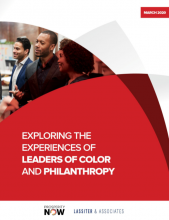In Exploring the Experiences of Leaders of Color and Philanthropy, a joint publication by Lassiter & Associates and Prosperity Now, one of the five major experiences of leaders of color included a lack of diversity in the philanthropic/nonprofit sector. All participants in the discussion felt that a lack of racial diversity in decision-making positions at the highest level of funding communities was a major challenge. At the time of publication:
- the proportion of women working full-time positions in Foundations rose less than a single percent between 2006 – 2015
- the proporation of full-time minority employees only rose 1.68%. over the same period
- the percentage of women and minorities in executive leadership positions did not change significantly at all

This is a surface level view. When people talk about systemic racism, what do they mean?
- Americans of color are affected disproportionately by poverty, drops in income, and lower accumulated wealth per income range than their White counterparts.
- The racial divide in access to wealth also means a divide in access to leadership roles.
- Without intentional planning and examining how leadership programs recruit, support, and educate people of color, existing patterns of racial inequality will continue to be reinforced.
Where are we today?
The 2020 Diversity Among Philanthropic Professionals Report by Change Philanthropy, reveals a sector that is making slow progress. The percentages of people of color, people born outside of the United States, and people with disabilities in philanthropy all increased.
A caveat: across various staff roles, people of color were most represented in program staff.
The bad news:
People of color working in philanthropy were 33 times more likely to feel exploited in the workplace than white people.
Lesbian and gay people were nearly twice as likely to report a negative reception
More than 1/5 of people with disabilities feel “invisibilized” in the workplace.
There is still a “tale of two sectors” as nonprofits that explicitly state they have a social justice focus are well ahead of other organizations when it comes to themselves having a diverse staff, board, and management. Community Foundations continue to lag behind others in the sector,
We have this information, now what do we do about it? How can we, as social justice advocates, change makers, and leaders, make real progress?
Be honest. Look at the existing culture of your organization; examine the motivations and commitment of your leadership; and consider what needs to change.
Explicitly commit to diversity, equity, and inclusion values and efforts — and work to embed them into the DNA of your organization.
Engage in an ongoing process of auditing and adjusting your own diversity and inclusion policies and practices.
Adjust your policies to support a diverse workforce, and align with current best practices. For example, ensure benefits provide adequate leave time, support a diverse range of family configurations, and accommodate individuals with differing abilities.
Create a culture where ongoing learning around cultural competency is both encouraged and expected.
There is no final point where you can say “We’ve achieved our goals, and we are now done in this space.” Keep moving. Keep doing the work.